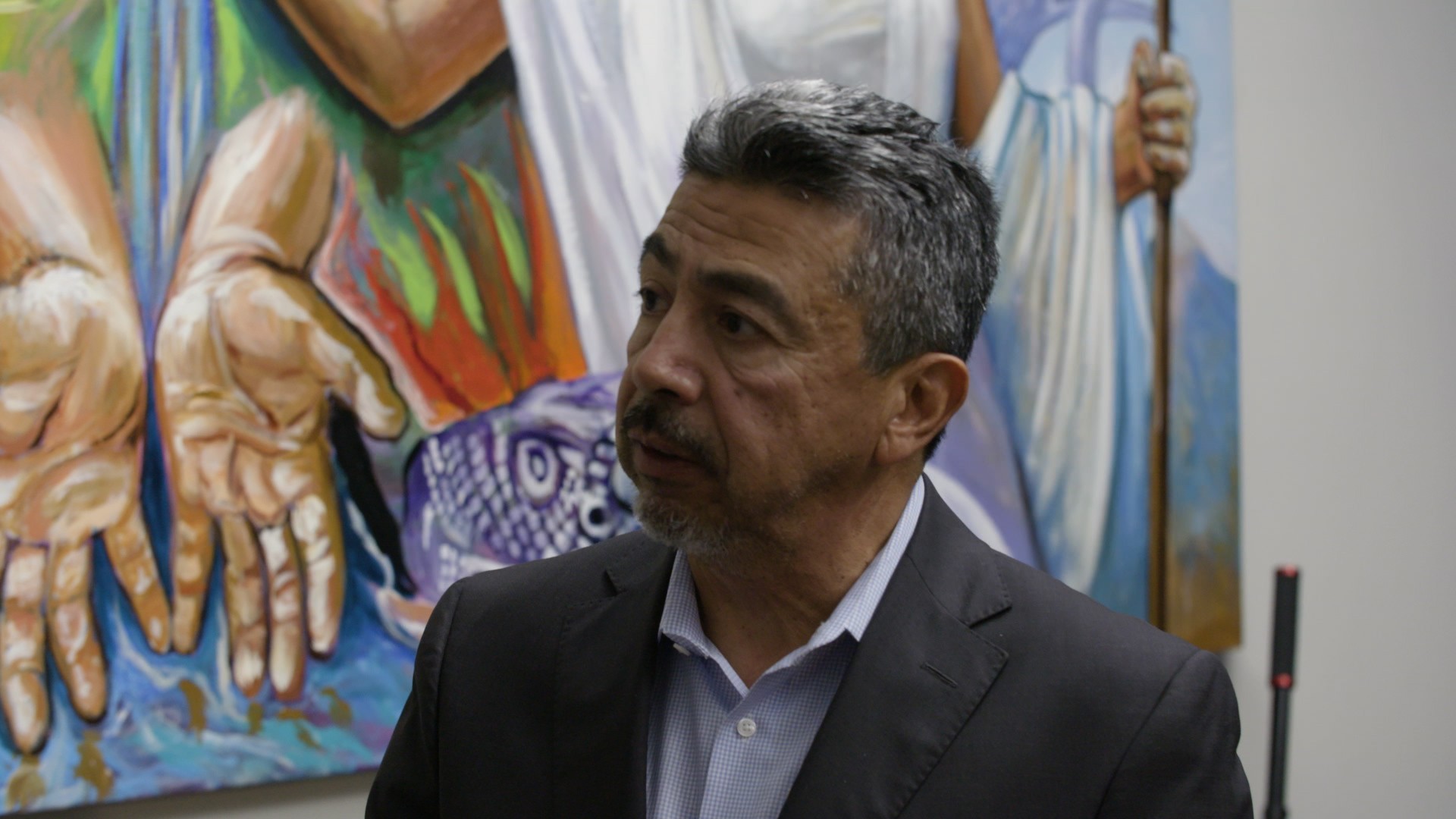Left Image: Photo of a 2018 enforcement action at a workplace in Salem, Ohio, courtesy ICE. Right Image: A girl watches a workshop for immigrants about ICE confrontations in Los Angeles, California (Photo by DAVID MCNEW/AFP/Getty Images)
From the outside, East Oakland's Bridges Academy at Melrose might seem unremarkable. Low-slung and shrouded in fog, it sits a short walk from the Coliseum Public Market, an old-school swap meet full of Raiders jerseys and Pitbull puppies and kids sporting home-brewed MAC Lipglass. Ninety-five percent of the school's students ate free or reduced-cost lunches of bean and cheese pupusas or soy butter and jam last year, and 88 percent were Latino, a fact as obvious as the grizzly on the state flag and the grills on the windows.
What sets these students apart is that dozens of them are Mam-speaking newcomers from the western highlands of Guatemala, whose friends, neighbors, and educators have joined a national movement to shelter immigrant children where city and state "sanctuary" laws have fallen short.“In California, we’re lucky—it’s hard to keep up with everything that’s happening,” said René Peña-Govea, a school librarian in neighboring San Francisco and one of the San Francisco Unified School District's (SFUSD) refugee and immigrant student liaisons, a position her students fought to include in local sanctuary rules last year.

In relatively liberal cities like Houston, such "sanctuary school" policies have been counted as among the only official protections immigrants have in public institutions in the Trump era. But in places like California, where defenses are more robust, schools have become clearinghouses for legal advice, community organizing, and even immigrant bond funds.“They do have a real impact in the sense of reassuring students and their parents that the school is not collaborating with ICE,” said Shiu-Ming Cheer, a senior staff attorney at the National Immigration Law Center. “Some actually put resources into the policy,” with teacher trainings, bilingual social workers and stipended advisors for undocumented student clubs, which Cheer said “could result in very tangible benefits.”Often, the difference between rhetoric and results are students themselves, as youth activists from San Francisco's 415 Unidos for Freedom recently learned."[Officials] proudly say, 'We’re for immigrants, we support immigrants,' but just saying they’re supporting immigrants is not enough," said Erick Reyna, a 26-year-old co-manager of the 415 Unidos campaign. "Our students noticed that when they went to visit [administrators] there wasn't much being done, even after the [2017] resolution was passed. Only three principals out of twelve even read the resolution."Instead, students have organized into "undocumented clubs" and storytelling workshops that process encounters with ICE. LA Unified now boasts an entire website dedicated to its sanctuary services, including an automated request form for Know Your Rights workshops and a DACA vertical that steers students directly to the district’s chief education counsel. In New York City, immigrant-rights groups have partnered with the Mayor’s Office to shepherd immigrant students into Pre-K and 3-K programs. And Oakland Unified officials told me they can now robocall parents in the event of a confirmed ICE sighting near campus, and that they've begun to collect special emergency contacts for an immigration crisis.“We’re trying to get beyond a fear-based response and to do the deeper work of what does it mean to have a new generation of youth who feel empowered and engaged and see themselves as resources and allies to each other,” said Nicole Knight, executive director of English Language Learner and Multilingual Achievement at the Oakland Unified School District (OUSD). "That’s really what we’re working to build."Meanwhile, smaller districts in some of the country’s most conservative states were quietly copying the work of big coastal metropolises, Cheer noted."It’s generally hard to find all of them because they might not have the word immigrant in the title, or school boards might pass them more quietly because they’re concerned about pushback,” she said. “It’s a place where there has been good momentum.”Schools are already uniquely safe spaces for immigrants—or at least have been historically. ICE itself (still) considers them “sensitive locations” like churches and hospitals, and forbids enforcement activity there except in extreme circumstances. Some sanctuary statutes bar schools from sharing information with ICE and require agents be vetted by a high level administrator—usually the district superintendent—before they can be allowed on campus, except in extreme circumstances. Such policies are bolstered by the Supreme Court decision Plyler v. Doe.But the memo behind ICE's "sensitive locations" policy is guidance, not a law, and could be revised or rescinded. Advocates I canvassed didn't expect that to happen, but many wanted schools to be ready just in case.
As of this summer, all California school districts were issued guidance on sanctuary policies that met a minimum level of protection far exceeding the 2011 ICE directive banning arrests, interviews, searches and most types of surveillance at schools—and some districts nationwide were following suit."These schools are doing all they can to protect the physical area they control,” Cheer said. “The biggest hole is that they can’t stop ICE from enforcement activities right outside of the school.”Such incidents are not exactly unprecedented. Thirteen-year-old Fatima Avelica could be heard weeping as she filmed her father's arrest by ICE just moments after he dropped off her younger sister at school in Los Angeles last year. The video galvanized students across the district, and led to aggressive new protections there."We created a reference guide which gives support and guidance for schools if ICE were to come onto the campus," said Nicole Mitchell, coordinator of the district's School Enrollment Placement and Assessment Center. Official response to such an event would likely include the district's Office of General Counsel and Los Angeles School Police Department, among others, she said.The second-biggest hole may be students like the Mam-speakers of East Oakland, who are often in removal proceedings long before they reach school, local activists said. Among those most recently enrolled was a fourth grader whose mother was in detention in El Paso and a first grader whose father was deported to Guatemala without him, the advocates said.Such cases have spiked in the past several months, according to Trevor Houser of the Immigrant Family Defense Fund, an Oakland-based legal aid group he founded with Etel Calles, Benita Jain, and Marco Palau in 2016. The group has tended to host house parties in the city’s more affluent neighborhoods to help* fund lawyers for “a couple hundred new unaccompanied youth each year” and to help bond parents out of ICE detention.“We work very closely with the Immigrant Family Defense Fund,” Knight, the OUSD administrator, told me. “If someone is allowed to and able to post bond, their case is de-prioritized and placed at the end of the docket since they are no longer taking up a detention bed,” making bond one of the most effective tools that activists can leverage against immigration enforcement.But advocates tended to agree that the most important work schools could legally right now do was simply to help young immigrant children feel safe.“It’s not just about protecting students and protecting their records, it's providing social emotional support,” said Rita Rodriguez-Engberg, project director of the Immigrant Students' Rights Project at Advocates for Children of New York. “I’m a naturalized citizen myself, and you just never know. I honestly feel like nobody feels safe right now.”*Correction 10/03/2018: A previous version of this story suggested the Immigrant Family Defense Fund paid fees for Oakland-area youth and families on its own whereas it is in fact part of a larger constellation of groups contributing to such expenses.Sign up for our newsletter to get the best of VICE delivered to your inbox daily.Follow Sonja Sharp on Twitter.
Advertisement

In relatively liberal cities like Houston, such "sanctuary school" policies have been counted as among the only official protections immigrants have in public institutions in the Trump era. But in places like California, where defenses are more robust, schools have become clearinghouses for legal advice, community organizing, and even immigrant bond funds.“They do have a real impact in the sense of reassuring students and their parents that the school is not collaborating with ICE,” said Shiu-Ming Cheer, a senior staff attorney at the National Immigration Law Center. “Some actually put resources into the policy,” with teacher trainings, bilingual social workers and stipended advisors for undocumented student clubs, which Cheer said “could result in very tangible benefits.”Often, the difference between rhetoric and results are students themselves, as youth activists from San Francisco's 415 Unidos for Freedom recently learned."[Officials] proudly say, 'We’re for immigrants, we support immigrants,' but just saying they’re supporting immigrants is not enough," said Erick Reyna, a 26-year-old co-manager of the 415 Unidos campaign. "Our students noticed that when they went to visit [administrators] there wasn't much being done, even after the [2017] resolution was passed. Only three principals out of twelve even read the resolution."
Advertisement
Advertisement
Advertisement
Advertisement
